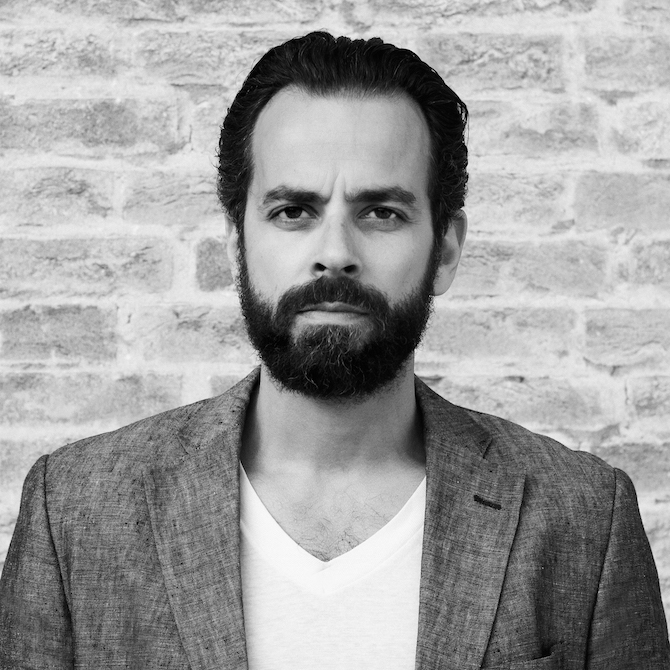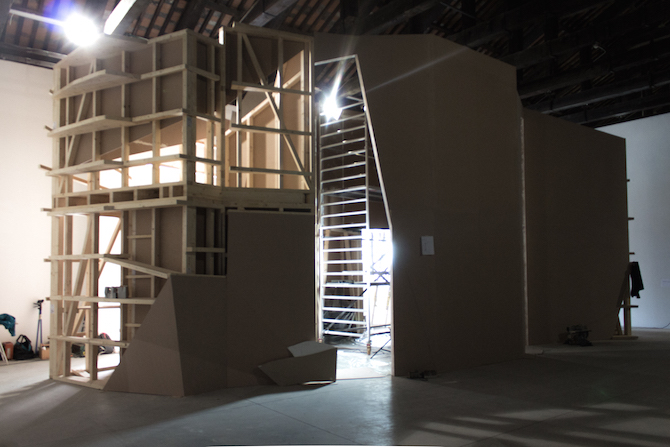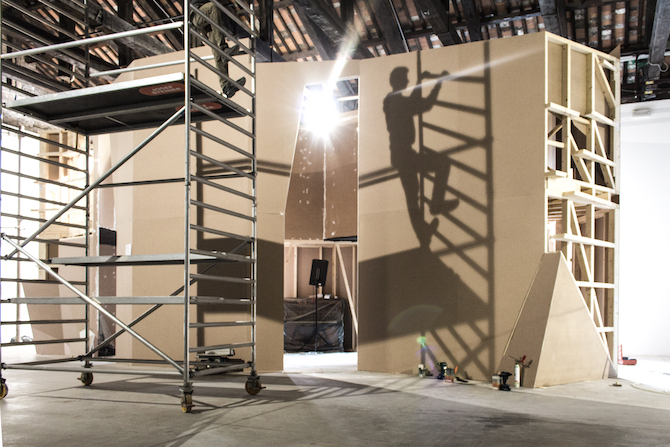

Portrait of Michele Drascek, photo by Rosa Lux; Construction site, installing UTTER at Arsenale- la Biennale di Venezia, photo by JAŠA
The subject of the upcoming exhibition at the Slovenian Pavillion for Venice Biennale is bombastic: Hope, and its creation through the power of cooperation is what the Slovenian performance artist JAŠA, the Italian curator Michele Drascek and a large group of other collaborators are aiming to achieve with their exhibition. Staged in a two floored architectural wooden construction, their joint project "UTTER. The violent necessity for the embodied presence of hope" is a durational performance that will proceed from the 9th of May until the 22nd of November 2015. Involving music, visual and performance-based elements, the choreography of the project will be repeated 28 times within a strict weekly plan – something that they call 'a structured act of discipline'. And although each participant produces a creative output, the project centres entirely on the communication with the public and the spectators. I spoke to Michele Drascek about the ambitious project, about his personal motivation and his hopes.
Anna-Lena Werner: Michele, you are the curator of the Slovenian Pavilion at the upcoming Venice Biennale. When did you begin developing ideas for the project UTTER?
Michele Drascek: Everything started with the project Crystal C, a project that I curated first in Lubiana and then in New York between 2013 and 2014. This was the start of the intense collaborative work between JAŠA, the producer and art director Rosa Lux and me. We have worked together in the past three years, jointly deciding to apply for the participation in the Biennale through the open competition from the Ministry of Culture.
Anna-Lena Werner: What fascinates you about JAŠA's work?
Michele: I met JAŠA in 2006, when I moved to Lubiana. Since then I have been following his work. What fascinates me is the overall experience that his work produces, the capability to transform spaces and to create situations that overturn the actual environment. He states strongly that poetry is a key element in the production, realisation and development of art projects, going beyond the fear of expressing beauty as a key element.
Anna-Lena: Hope is the subject of the exhibition. How is this expressed?
Michele: Hope is also related to the themes of resistance and collaboration. Jaša will use the Biennale as a platform: he will demonstrate that an act of resistance, in this case duration, structure and constant presence, and collaborative work or collaborative experience is the real way to move forward. The real way to enhance a process of coexistence in a moment where individualism is the wrong key to resolve difficult political and social situations. This is how a message of hope will be addressed. It is a method, a stance and a practice. Jaša is interested in finding the right physical composition based on a perceptual and emotional communion with the spectators. And this communion, we hope, will create moments of harmony.
Anna-Lena: Collaboration as a non-violent revolution?
Michele: Exactly, that is the point. Jaša would speak of an overall experience of solidarity.
Anna-Lena: What do you think is the task of art in a political world? Does it have a responsibility?
Michele: Art should formulate a vision, using poetry as a stance. It can have a responsibility, indeed, and it could be political. In the case of UTTER, for example, the durational performance is a tool to demonstrate that transformation needs commitment and cooperation: this is a political standpoint.
Anna-Lena: Your project involves sculptural aspects, architecture, music, acting, poetry. How is all this coming together?
Michele: The installation has been developed with the collaboration of the architect Kuno Mayr as an architecture within the architecture, but the result is a sculptural structure that provide space for the performance. It involves a first floor, from which only the performers operate. There is also an archive or library that we use to write down and store our experiences throughout the Biennale. The installation in itself is a tool to produce music, for example with a live piano. We consider the whole project as performance based. A durational performance that will start with the preview week at Biennale and will continue until the very end, on the 22nd of November. The weekly plan covers every day, structured but not just repetitive. The installation, therefore, is a sort of architecture of actions.
Anna-Lena: Will most elements be ephemeral and performance based?
Michele: There are several sculptural elements, also provided by the various collaborations with other artists, who will install their kinetic elements in the structure.
Anna-Lena: Who are these collaborating artists and what will they contribute?
Michele: While JAŠA, Junzi and me are the main performers, we work with a long list of collaborators. These include, for example the choreographer Lisa Josephine Vereertbrugghen and the artist Meta Grgurevič. And we also work with a New York-based team, such as the writer Etan Nehcin. Also, a group of students from the Accademia di Belle Arti di Venezia will participate.
Anna-Lena: You mentioned a piano and the presence of music. How exactly is sound involved in the installation?
Michele: Music is used in the space and within the space. The installation in itself operates as a harmonic case. There will be both electronic and classical instruments, counting as any other tool of expression. In the past JAŠA produced an album with a group called LEFT FINGER. For UTTER, he is developing music with the musician Bowrain. A piece is already published online.
Anna-Lena: The structure, which I believe exists of wooden frames, becomes an architecture. You used the term three dimensional poetry…
Michele: …yes, we use that expression. But there is a fourth dimension as well: the emotional impact of the happenings within the space through an organic work, with its own structure and integrity.
Anna-Lena: What is your personal motivation to concern yourself with the subject of hope?
Michele: I think that hope has been used as a motionless vehicle. Like a hypothetic result of something that does not require action or actions. My concern, also generally speaking as a person involved in culture, is to promote a vision of hope that has concrete grasp on reality. Actions, responsibility, motivation. I think that individuality is the prior enemy of a vision that wants to create transformation.
UTTER / the violent necessity for the embodied presence of hope
JAŠA
9. May – 26. November 22nd, 2015
Venice
Opening hours: 10 am – 6 pm, Mondays closed (except 11.05, 1.06 & 16.11)
JAŠA
9. May – 26. November 22nd, 2015
SLOVENIAN PAVILLION
Pavilion at Arsenale - ArtiglierieVenice
Opening hours: 10 am – 6 pm, Mondays closed (except 11.05, 1.06 & 16.11)

 Construction site, installing UTTER at Arsenale- la Biennale di Venezia, photo by JAŠA
Construction site, installing UTTER at Arsenale- la Biennale di Venezia, photo by JAŠA